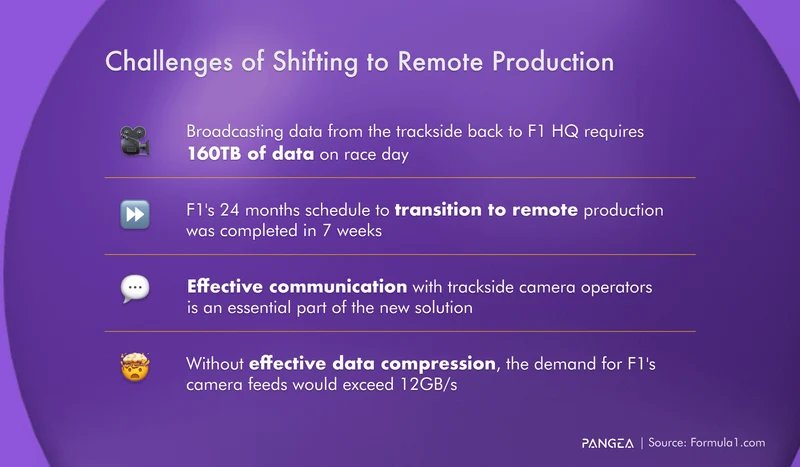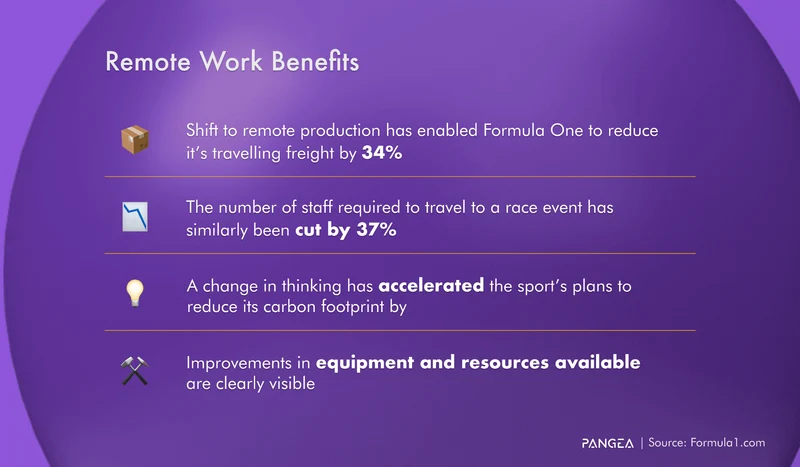Formula 1 Goes Remote
Widespread industry changes happen only when technologies, attitudes, and expectations reach a tipping point when adoption is simply inevitable. Time and again, software companies, in particular, have seen novel platforms and tools become essential industry standards, seemingly overnight.
The shift towards having a remote and distributed workforce—an idea often talked about, evaluated, and considered within firms for years—has now reached that tipping point. In software development and beyond, companies across the globe have adopted remote working as standard practice, including the iconic racing organization, Formula 1.
Even before the pandemic, Formula 1 management had mapped out a gradual adoption of remote production over several years, with controlled trials leading up to 2023. But like many firms during 2020, new restrictions forced the company to change gears faster than planned, adapting their working model in just seven weeks.
This article explores what happened when one of the world’s largest production companies were forced to throw out the rule book and change their thinking on a dime.
Formula 1’s Rapid Shift to Remote Production
Amidst new travel restrictions, safety precautions, and personnel challenges curtailing just about everything required to broadcast a race weekend, Formula 1 management were forced to re-think their entire production model from the ground up in the middle of the season.
These changes, in practice, would mean completely overhauling methods of television production that had worked successfully throughout the industry for decades. In their place would be new technologies, new ways of thinking, and an approach to the task filled with risk and uncertainty.
The conventional way to televise a live racing event would be to employ a travelling crew of 200-300 staff to attend every meet on the sporting calendar. In the case of Formula 1 racing, this meant 23 races per year where a dedicated team would arrive at the circuit to cut together the trackside cameras, onboard views, roving reporters, and aerial shots into a cohesive story to be served via satellite broadcast for the world feed.
The changes required to take this process and turn it into one that could be done remotely, with barely a fraction of the original travel necessary, is not one that was intuitive or obvious at all.
The data requirements alone would be a technical challenge impossible to overcome just a few years ago.

More than one hundred 4k streams go into the coverage of every Formula 1 event, each of which need to be broadcast live all the way back to Formula 1 Headquarters in Biggin Hill, England. Accomplishing this feat from 23 different countries across six continents required a massive shift in thinking and planning of the likes that has rarely been seen before.
Formula 1’s Transition to Remote Television Production
The first major challenge in making Formula 1 remote production work was finding out how the broadcaster could deliver over 160 Terabytes of data from the trackback to HQ during a racing event. So, Formula 1 management reached out to key technology partners in various industries, and tier-one network provider Tata Communications stepped in to offer a fibre solution to one of the business’ most pressing problems.
As a tier-one service provider, Tata Communications is responsible for the physical infrastructure that commercial internet service providers depend on. For Formula 1, this puts the company in a position to supply large amounts of bandwidth and the guaranteed uptime required for a successful racing weekend.
That such infrastructure exists is a significant paradigm shift from the satellite transmission technology that had made up the backbone of televised sporting events since the 1960s. Today, fibre transmission offers a high-speed, low-latency, and reliable connection, which has led it to start dominating sports broadcasting worldwide.
Additionally, to facilitate changes across all their platforms, Formula 1 have engaged partnerships with cloud-based service providers AWS and Zoom. These partnerships ensure further opportunity exists for the organisation’s streaming services and communications networks in the future.
By making such a drastic and comprehensive shift in such a short time frame, Formula 1 has demonstrated that, even in the most challenging of circumstances, shifts in attitudes, thinking, and expectations are entirely possible.
Advantages of Formula 1’s New Paradigm Changing Production Model
The emergency shift away from trackside operations and into remote production was a drastic measure to provide television coverage of the 2020 Formula 1 season, but the change comes with numerous advantages for the sport.
Amongst these advantages is a vast reduction in the budget and travel necessary to produce the same content. The number of travelling staff required to attend a race event has been slashed by nearly 40%, while the freight necessary to facilitate production has been cut by 34% during the same period.
Since implementing these plans, Formula 1 television production has also seen a remarkable uptick in efficiency. Teams working in a familiar and controlled environment, one that’s guaranteed to be well-equipped and ready to host a race weekend, are able to deliver greater assurances about their end product.

With new changes in place, staff have been able to operate more flexibly than a travelling schedule would allow, and create higher quality content as a result. Building on the lessons learnt and the technologies implemented to enable remote production, the potential exists to expand the capabilities of the business beyond what was previously thought possible.
In a short period of time, the operational, financial, and environmental impacts of Formula 1’s switch to a remote production model have been a powerful asset to the sport. Despite being enforced by circumstance, it’s one that Formula 1 Racing intends to stick with well into the future.
The Future of Formula 1’s Remote Production Model
Beyond Formula 1, the shifts that make remote production of television broadcasting possible are having a widespread impact on the industry. The MotoGP motorbike racing series and NASCAR Championship have also adopted new ways of working into the future. Further afield, football championships, rugby fixtures, and horse racing meets have also leant on remote production to support their own broadcasts.
While the technology to achieve these feats has been available for a few years at least, it’s the change in attitudes, thinking, and expectations during the Pandemic that are responsible for the sudden shift in practice.
Now, as things largely return to their previous state, the advantages of improved communication, reduced costs, enhanced efficiency, and increased output have proven too powerful to give up to return to the old ways of thinking.
Changes that may well have stalled indefinitely without a major catalyst are now a cornerstone of the broadcast industry—showing that being forced into new ways of thinking can, at times, have a lasting positive impact far larger than the one you imagine.
The affinity for Formula 1 spans several generations within a family. Formula 1 has innovated and reinvented itself time after time to stay on top for decades. But it has been an organisation that has traditionally operated with significant manpower. Makes sense with the nature of organising world-class races worldwide.
With this in mind, their move into remote production is a spectacular milestone. Cementing remote-first as the way forward in a post-pandemic world. Both for brands of the past, and brands of today.
At Pangea.ai, we are inspired by Formula 1, but we are not surprised. For over half a decade, we have seen smart businesses go remote. Forward-thinking companies have hired software development talent within our remote community to accelerate their digital agendas.
But still today, there are stakeholders and businesses that doubt if remote, in any form, is possible for them.
Well, think about it this way. If Formula 1, with a complex production schedule and process, can go remote, don’t you think you can run parts of your business remotely? And, in other words, leaner and more efficient as Formula 1 discovered?
What we can offer is to help you go remote with your hiring needs in software development. Get in touch and we will guide you through the landscape of hiring elite talent, remotely. That being said, here to the Formula 1 team for paving the way and ensuring several generations in the future will enjoy a world-class experience in racing - well done!
